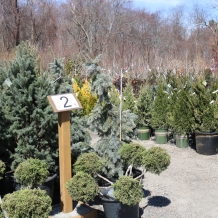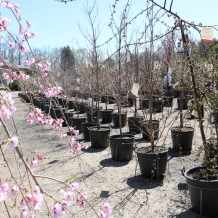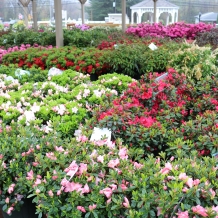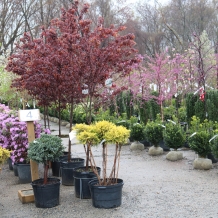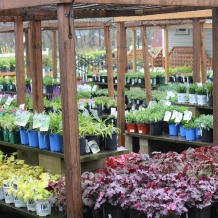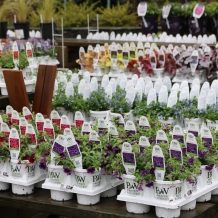More Planting Tips…
Plant Selection
Plant selection and design involves a lot more than simply selecting plants based on aesthetic considerations such as color foliage or flowers. The most important aspect of plant selection is appropriately matching the plant with the planting site. Every plant species has its own cultural requirements including growing space, light, moisture, drainage, soil conditions and more. Every plant species also has its own climatic or environmental requirements. This includes not only the climate of the specific region, but also the microclimate of the planting site. The proximity of other structures, neighboring trees, topography, pavement and exposure to salt spray can all detrimentally impact the success of a plant. It's also important to match plants to their desired function, such as creating shade over a patio.
Planting Trees & Shrubs
Trees and Shrubs can be planted at any time during the growing season. Fall and early spring are the most beneficial times of the year to plant. When planted in fall, the warmer soil encourages increased root growth and nutrient uptake. In the fall, roots can start to establish before the plant goes dormant for the winter, which in turn increases blooms and fruit production the following season. When planted in early spring, before bud break, light, temperature and soil moisture are all at optimal levels for root establishment. If adequately watered and maintained, container grown trees can be planted from early spring till late fall. Plants establish most quickly when soil temperatures are warm and moisture availability is adequate, but not excessive. Planting requirements may vary given the plant species and site and soil conditions.
At our nursery trees and shrubs are commonly grown in one of two forms. Most of our plants are container-grown, while some are field grown and burlapped. Plants dug from the fields using burlap to hold the integrity of the root mass in place are referred to as balled and burlapped. Planting procedures differ slightly for containerized and balled and burlapped plant material.
Containerized Plants
Container grown plants may be planted anytime of the year, as long as the soil is workable. Refer to the "Steps for Planting Success" tab for detailed planting instructions.
Balled and Burlapped Plants
When balled and burlapped trees or shrubs are brought to the nursery, excess soil is often collected too high up the trunk. There may also be excess rope or burlap that is tied above the root flare due to different production techniques. It is imperative to locate the natural root flare of the plant before planting. The root flare is the transition zone between the main stem and the root system. This area must be exposed. If it is not, the plant may be planted too deeply which may ultimately cause plant mortality. If the plant is planted too deep in the ground, or has too much mulch around it's base, this will cause the roots and the tree trunk to suffocate. Excess soil or mulch will limit the supply of oxygen to the roots and will slow down the conduction of water and other vital nutrient uptake from the roots to the leaves.
Start by loosening the burlap and rope at the top of the root ball before the planting hole is dug to properly locate the root flare. This will allow you to properly judge the correct planting depth of the planting hole. Once you've determined the proper planting depth, dig your hole and follow the instructions in our Planting Guide found under the tab "Steps for Planting Success". You can leave the burlap in place when you initially place the plant into the planting hole. Backfill by placing enough of the existing soil around the bottom of the root ball to adequately support the plant in place. Firm, but do not pack, the soil around the base of the ball. Then, remove as much burlap and rope as possible without affecting the integrity of the root ball. If the balled and burlapped plant came with a wire basket it is preferable to cut away the upper one-third to one-half of the basket with bolt cutters to prevent future problems. Continue with the steps recommended in our Planting Guide.
Pruning
Pruning directly following planting should be limited. A plant will establish and grow more quickly if pruning is minimized at planting. Although structural pruning of young plants can be beneficial to the success and the longevity of the plant it is preferable to start theses procedures only after the plant has been established in the ground for a year or more. The only pruning that is suggested at planting is the removal of broken or damaged branches.
Staking & Guying
Staking of newly planted trees is typically unnecessary. Staking can have negative effects on tree development. Staked trees will commonly develop a smaller root system because the tree accustoms itself to having added support in the form of stakes, rather than a deeper and more stabilizing root system. After the stakes are removed the tree is more subject to breaking or tipping over. Staked trees are also shown to produce smaller caliper trunks with less trunk taper. Staking may be necessary with specific site conditions. For example, staking may be necessary on a windy site involving a tree with a tall, heavy canopy and a less than adequately sized root ball. In some cases staking is used to aid in reducing movement of the root ball, therefore reducing potential damage to the fine, absorbing root hairs. If staking must be used, the material used to attach the tree to the stake should be smooth, strong, and somewhat elastic. Support stakes or guy wires should generally be removed after one growing season to prevent girdling injury.
